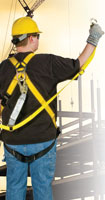
Accommodating Heavy Workers
While compliance and user right-to-work are important issues to maintain, employers should consider workers' health in the event of a fall.
- By Marc Harkins
- Jul 01, 2009
User weight is an important consideration when determining personal protective equipment for workers. Most fall protection product capacity rates up to 310 pounds, a weight aligned with most safety standards' and regulations' test criteria. Users should note that product capacity is more than just user weight, because it includes all clothing and equipment attached to the worker.
Several fall protection manufacturers design higher-weight capacity equipment, some of which is rated up to 400-pound capacity. Most higher-capacity harnesses are approved on product strength in the event of a fall; current ANSI standards do not call for other special heavy-worker requirements. CSA Z259.10-06 lists harness capacity requirements up to 175 kg (385 pounds). Energy-absorbing lanyards for heavy workers are commonly tested to keep fall forces under 1,800 pounds, which aligns with OSHA requirements. CSA Z259.11-05 designates the classification E6 for heavy workers. Energy-absorbing lanyards meeting this classification are designated for workers 90 kg (198 pounds) to 175 kg (385 pounds), while also keeping forces below 1,800 pounds in any type of fall.
While compliance and user right-to-work are important issues to maintain, employers should consider worker health in the event of a fall. While personal protective equipment may have the strength to stop the worker from falling to the ground or the lower level, typically, heavy-worker fall forces will be higher than that of average-weight workers, leading to the need to review the entire fall protection system as well as the individual's overall health and physical condition.
Questions for consideration before any action include:
Can the structure support potential fall forces?
Is the anchorage connector rated for higher capacity?
Is the lifeline rated for higher capacity?
Is the harness rated for higher capacity?
What is the rescue plan if this worker falls?
Rescue plans for heavy-weight workers are of significant importance because plans may differ from those of typical job-site rescues. Rescue equipment may need to be more robust, and rescuers may need to use other methods to save suspended workers. Suspension trauma, which is caused by the body's slowing of blood flow, may take effect at faster rates, making the time necessary to rescue someone more critical as each minute passes.
Selecting a full-body harness based only on industry compliance may not be the best plan for heavy-weight workers. Instead, these workers may want to consider upgrading their protective equipment to include extra padding around key areas, such as the shoulders and sub-pelvic region, where harness pressure is greatest. Padding or wider straps in these key areas distribute forces over broader areas, lessening post-fall suspension effects. Other accessory items such as safety steps (etriers) can also improve user comfort while workers wait to be rescued; these devices allow users to alleviate sub-pelvic region pressure while suspended. Suspended workers also can continue lower body movement while suspended, helping blood flow to continue and decreasing blood pooling potential.
While off-the-shelf solutions may not always be readily available, some manufacturers are willing to customize fall protection products to ensure a better fit for higher-capacity users. Tailoring the full-body harness to fit more comfortably in the torso and sub-pelvic areas will increase the likelihood of the harness being worn properly, helping to minimize potential fall injury. The ability to adjust an energy-absorbing lanyard's length can minimize free fall distance during a fall; an adjustment of just a few feet could save the worker from hundreds of pounds of extra force on the body.
This article originally appeared in the July 2009 issue of Occupational Health & Safety.
About the Author
Marc Harkins has served MSA in several pivotal roles during his twelve years with the company. Harkins served as Fall Protection Product Specialist, Market Research Analyst, Custom Products Product Line Manager, Customer Development Manager and, most recently, Product Group Manager for Fall Protection. Harkins received his Bachelor’s degree in Business Administration from Westminster College and his Master’s degree from University of Colorado. His educational background, combined with and his years of customer service, sales and marketing experience, has earned him a Representative seat on the ANSI Z359 Committee, ISEA Fall Protection Sub-Group, and the ANSI A10.32 Sub Committee.